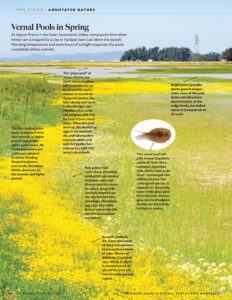I don’t usually like to leave the Bay Area in April, my favorite time of year around here. I’d rather wait until summer, when the hills have turned golden. But the invitation to spend a week kayaking in the Sea of Cortez off Baja California was just too good to pass up. So off I went, leaving the flowers still blooming on the hillsides at home.
In a way, I wasn’t completely leaving home; I was still in “California,” after all. Our first night on the beach at Isla Espiritu Santo, a great blue heron came and sat on a nearby rock as I watched the sun go down. Looking west across the Sea of Cortez to the Baja peninsula is a bit like watching Point Reyes across Tomales Bay: in both cases, the land in view is moving northwest—very slowly, to be sure—on the Pacific Plate. While the San Andreas Fault that governs the Bay Area topography doesn’t quite extend down to the Sea of Cortez, the Sea itself, like Tomales Bay, is on the border between two tectonic plates.
Of course, you’d never confuse the two areas. In Baja, the sun and heat are an insistent presence throughout the day. Instead of hillsides cloaked in wildflowers, Douglas fir forests, and oak woodlands, the islands of the Gulf of California offer multihued volcanic rock and card—n cactus. The Gulf’s waters are a deep blue in the open sea, shading to translucent turquoise along the sandy shores—quite a contrast to the steely and turbid gray green of our cold home waters. And living under the surface is a profusion of fish and invertebrates, in all the colors of the rainbow, easily visible with mask and snorkel.
In fact, the Sea of Cortez is considered to be the biologically richest body of water in the world, outpacing prolific San Francisco Bay. Like the Bay, it too is threatened by the human race and the market economy. And yet, also like the Bay, it remains a magnet for an abundance of aquatic life. We kayaked out to one small island that’s a breeding area for brown pelicans, cormorants, gulls, frigate birds, and boobies. The downy white pelican newborns were just visible in their nests. The cacophony of thousands of breeding, nesting, and fledgling birds reminded me of the din that engulfs the Farallones in early summer. Indeed, after the nesting season, many of these pelicans will head up our way, knitting together the two distant, distinct, yet connected waterscapes.
Between the pleasure of recognizing the familiar and the excitement of encountering the completely new, I realized what a privilege it has been to get to know an area—the Bay Area—in depth, and how opaque the world can seem when I’m not grounded in it. With no Baja Nature to answer all my questions—where did this volcanic rock come from? why do these fish come in such brilliant colors?—I felt somewhat at a loss on that desert island. It was thrilling to float on the surface of experience, but I also love to dive down and see what’s underneath.
Responding to the curiosity aroused by beauty is, in large part, what Bay Nature is about. The pillowy wave of fog pouring through the Golden Gate on a summer afternoon is both a seductive shape and a meteorological occurrence, and it’s a joy to be able to both revel in its unique form and understand why it’s happening. When a big, black bird swoops out of that fog and flies close overhead, that’s dramatic enough to make you stop and watch. But when you learn about how ravens have made their way back in to our neighborhoods after several decades’ absence, then your walk to the store or bus stop can take on a whole new dimension of adventure and discovery.
I returned home to the Bay Area in early May and was gratified to find the Marin Headlands still brilliant with checker-bloom, lupine, blue-eyed grass, and poppies cascading down to the cliff edge above the chilly Pacific. Some places wear their colors on hillsides; some display them most proudly underwater. But wherever it is allowed the space to breathe, nature provokes the richest visions, opens up the broadest vistas, and reveals the most surprising designs. It’s good to go away for a while. And it’s even better to come home again. Wherever you go this summer, keep a piece of the Bay Area with you. We’ll be here when you return.

.jpg)



